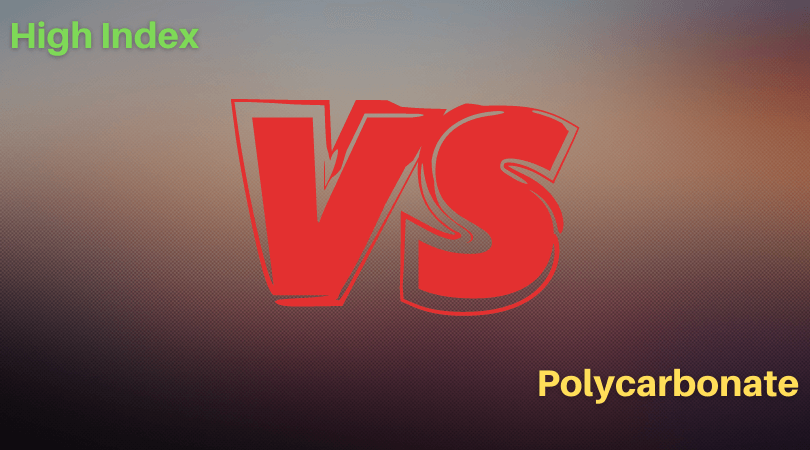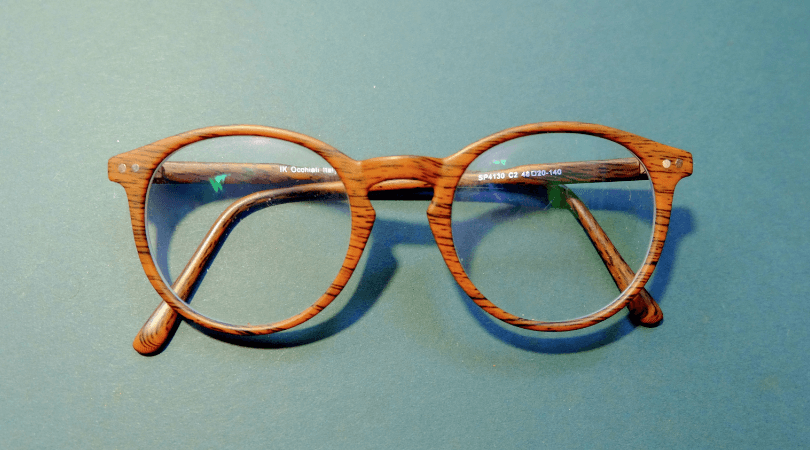Hello people, today I will share a detailed analysis of high index vs polycarbonate lenses. It’s always challenging to choose the best out of them. But I will make it a cakewalk.
Polycarbonate VS High Index Lenses
High index lenses are denser than lower index polycarbonate, making their lenses thinner to refract light perfectly. That means if a polycarbonate lens needs 2 millimeters of material to refract light, the high index may only need 1 millimeter.
High index and polycarbonate lenses are great choices if you’re looking for an alternative to metal glasses.
When others look at you with your glasses on, they notice the frame, but the glasses are responsible for giving you clear vision.
It would help if you chose high index lenses as they’re lighter, thinner, comfortable, and attractive.
Lighter and thinner high index lenses are highly recommended if you have a prescription for farsightedness or astigmatism and nearsightedness.
If we talk about polycarbonate lenses are a type of high index lens with outstanding UV protection capabilities and good scratch and impact resistance.
These glasses are handy for people working in jobs with high chances of eye injury and for anyone under 18 years of age.
However, choosing a lens material can be a real pain in the head. So I’ll try my best to analyze both materials.
Essential Factors to Consider While Choosing Lenses
As I said earlier, lenses are more critical than frames. Regardless of your choice, Lenses are for vision correction, and frames are for comfort and attractiveness.
If your frame is acceptable, your eyes will feel grainy and uncomfortable if you don’t have the right lenses. Your choice of lenses is completely dependent on your vision needs.
Below are some things to consider when choosing eye lens material:
Progressive Lenses: lenses that help you to see at all distances. Customizable lenses for your vision needs.
Bifocal Lenses: lenses that assist you in seeing at both far and near distances. Helpful even for people with two different prescriptions for lenses.
Single Vision Distance: Helps you to see clearly at a distance. In need of a stronger prescription to see clearly? Go for it.
Single Vision Reading: lenses to see things at a close distance.
Interesting Read – Polycarbonate VS Plastic Lenses | A Complete Analysis
Prescription Range is an Essential Factor
Prescription lenses are designed to refract light depending on the prescription. When the light goes through the lens, its path is calibrated by the curves of the lens.
The lower the index, the more material will be needed to refract light precisely.
In general, high-index lenses are prescribed for strong prescriptions. Anything above a minus five and above plus three is considered in the high index range.
High index lenses are denser than polycarbonate lenses, meaning they have thinner lenses to reflect light correctly. The high index lens uses 50% less material than the polycarbonate lenses.
Thickness and Weight Gets Affected by Lens Material
The high index polycarbonate lenses debate gets a lot of traction regardless of what you choose between them; it will replace metal and be 20% less thick.
However, thinner lenses are not lighter in weight. The exact property, which makes it thinner, also makes it heavier. Considering all things, polycarbonate lenses are 18% lighter than the high index.
Generally, it would help to use lightweight lenses rather than slightly thin ones.
Most opticians recommend that over a minus seven or a plus five should always be made with high-index lens materials.
In these strong prescriptions, the reduced thickness with the high index will compensate for the increased weight.
Polycarbonate Vs High Index Lenses: Which One Triumphs For Clarity?
Comparing all the mainstream lens materials, neither high index nor polycarbonate provides the best optical clarity. Materials like crown glass, Trivex, and CR-39 steal the show.
Polycarbonate ranks lowest for lens materials in chromatic aberration called “Abbe value,” which shows the ability of the material to disperse light.
High index lenses rank slightly more elevated than polycarbonate.
| Material | Abbe Value |
| Polycarbonate | 30 |
| High Index | 36 |
| Basic Plastic | 58 |
| Crown Glass | 59 |
As an average person, should you worry about Abbe’s value? I don’t think so.
Polycarbonate is a widely used lens material with more than 35% market share in prescription glasses. Most people can’t assess color deformation at these levels.
A Safety Factor
Without a doubt, polycarbonate is the most rigid lens material. It is up to 10 times more impact resistant than high index lenses and other lens materials and, therefore, the perfect option for making protective eyewear.
Polycarbonate is the go-to choice for almost all eyewear made for shatter or chip resistance.
The rigid thermoplastic is often considered 200 times stronger than glass and is thus utilized to make bulletproof windows and car shields.
A Host of Additional Features
Polycarbonate lenses are trendy in the lens market. Therefore, it is compatible with almost all mainstream add-on options.
Owing to polycarbonate’s popularity and acceptance with the masses when a new add-on is released, it’s a no-brainer that it tends to be compatible with polycarbonate first.
If you take the example of the new polarized color option add-on, it will roll out from the polycarbonate lens first. Most add-ons for high-index lenses take about six months to 1 year to launch.
Polarized filters are a trendy add-on for polycarbonate and high index lenses, but high-index might only offer two colors, whereas polycarbonate can offer up to 5.
High index lenses are not the best option to tint your lenses to a dark shade. High index lens density doesn’t allow it to be tinted to more than anything more than a light shadow.
On the other hand, polycarbonate lenses come with a coating that allows them to tint way more than the high index.
Engaging Read – Trivex VS Polycarbonate | The Definitive Guide
Bottomline Benefits: Polycarbonate Vs High Index Lenses
Polycarbonate Lenses:
- Tough
- Scratch-Resistant
- High Tinting Ability
- Durable & Impact Resistant
- UV & Blue Light Protection
- Thin & Lightweight
High Index Lenses:
- Lightweight
- Thinner material
- Optimum for people with farsighted prescriptions
- Attractive
- More comfortable for long term wear
FAQs

Below are the frequently asked questions on high index lenses vs polycarbonate. Let’s dig deep to learn more.
Are high index lenses more expensive?
Yes, high index lenses are more expensive than polycarbonate lenses because they are made from expensive materials, making the manufacturing process difficult and harder to grind. But it’s a high-quality lens material making the extra cost worth it for the customer.
Is there a big difference between 1.67 and 1.74 high-index lenses?
1.67 index lenses are ideal for prescriptions under +5.00/-8.00 and astigmatism correction between -3.00 and -4.00. 1.74 index lenses are the thinnest high-index lenses. This lens is acceptable for stronger prescriptions above +5.00/-8.00 and astigmatism correction between -4.00 and -6.00.
How much do polycarbonate lenses cost?
Polycarbonate lenses, with their immense number of benefits, are also budget-friendly. They are known to be cheaper compared to high-grade lens materials. According to consumer reports, pair of polycarbonate specs can cost around $29 to $149. The cost of plastic glasses varies depending on your unique requirements like thickness, strong prescription, weight, etc.
How much do high-index lenses cost?
If you are looking for high index lenses (1.74), you must pay between $180 and $230. Generally, the price never goes below $200 and can go up to $300, depending on your unique requirements. The price is also dependent on extras, add-ons, and coatings.
Fascinating Topics to Read
- UHMW Vs. Delrin: Which one is the Best?
- What is PETG Material? | The Definitive Guide
- Dielectric Strength of Plastics | Electrical Properties of Plastics | The Definitive Guide
- Top 6 Chemical Resistant Plastics
- What is the Best Plastic Glue? | The Ultimate Guide
- How to Remove Scratches from Plastic | The Ultimate Guide
Final Thoughts
That is all I wanted to say about High index vs polycarbonate lenses. Lenses are mere objects but integral to people who constantly wear them. However, all lenses are not created equal, but doing detailed research before purchasing your lens will provide you with a pair lens that bring vision and a sense of fantastic comfort to your life.
Both types of lenses have unique benefits; weighing your options and considering your needs before deciding is essential. A knowledgeable eye care professional can help you choose the best lenses.
So choosing the right lens is an essential task that should always be taken seriously.
Thanks for reading. Have a lovely day.
Quick Navigation




